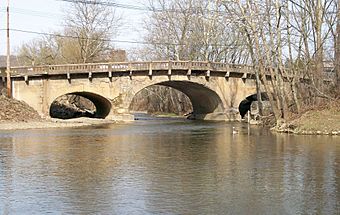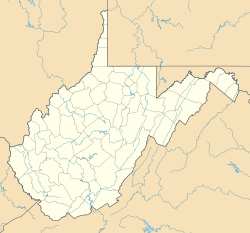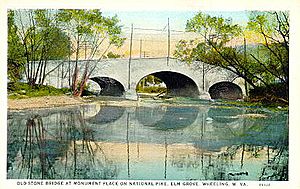Elm Grove Stone Arch Bridge facts for kids
Quick facts for kids |
|
|
Elm Grove Stone Arch Bridge
|
|

The bridge in 2010
|
|
| Location | |
|---|---|
| Area | 0.5 acres (0.20 ha) |
| Built | 1817 |
| Architect | Moses Shepherd |
| Architectural style | Stone Arch |
| NRHP reference No. | 81000606 |
| Added to NRHP | August 21, 1981 |
The Elm Grove Stone Arch Bridge is a very old and important bridge in West Virginia. It is also known as the Monument Place Bridge. Built in 1817, it is the oldest bridge still standing in the state.
This historic bridge carries U.S. Route 40 over Little Wheeling Creek. You can find it in the town of Elm Grove. Because of its age and importance, the bridge was added to the National Register of Historic Places on August 21, 1981.
Contents
Building the Bridge
The Elm Grove Stone Arch Bridge was built by Colonel Moses Shepherd. He was an important person in the Wheeling area. Colonel Shepherd was friends with Henry Clay, a powerful speaker in the U.S. House of Representatives.
This friendship helped bring the National Road through Wheeling. Colonel Shepherd was then given the job to build all the bridges for the National Road in Ohio County. Construction on the Elm Grove Stone Arch Bridge started and finished in 1817.
Bridge Updates Over Time
Even though it's very old, the bridge has been kept in good shape. It was updated in 1931 to make some changes. Later, in 1953, it was made even stronger.
Today, the Elm Grove Stone Arch Bridge is still used every day. It continues to carry traffic along U.S. Route 40, just as it has for over 200 years.
Bridge Design and Look
The Elm Grove Stone Arch Bridge is made of three stone arches. It was built using strong, solid limestone blocks. The entire bridge stretches 208 feet long over Little Wheeling Creek.
The middle arch is the widest, spanning 38 feet. The two arches on either side are each 25 feet wide. These arches have a special elliptical (oval) shape, not the usual half-circle. This design gives the bridge a unique "humpback" appearance.
Changes to the Bridge's Structure
In 1931, some parts of the bridge called buttresses were removed. This was done to add sidewalks on both sides of the road. This made it safer for people to walk across.
In 1953, a special material called gunite was sprayed onto the bridge. This helped to reinforce and strengthen the structure. The road surface has been paved with asphalt many times. However, these changes have not damaged the original design of the bridge from 1817.
See also




